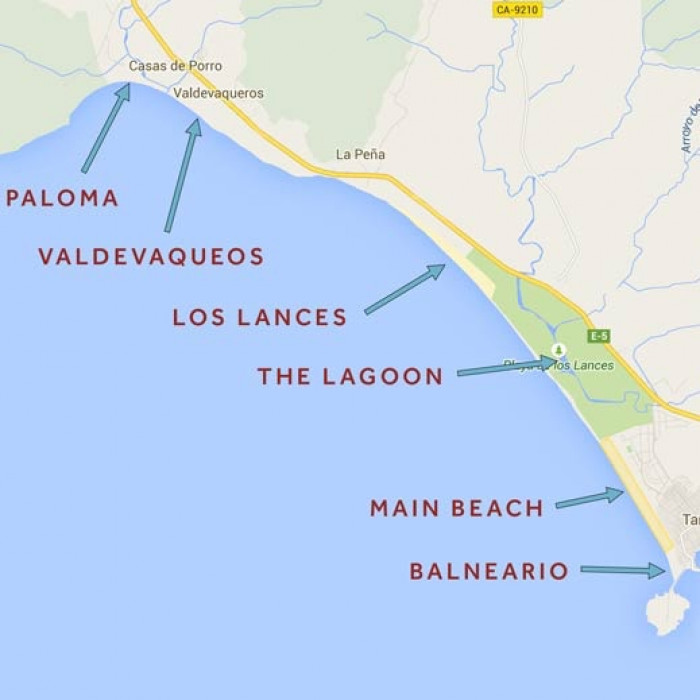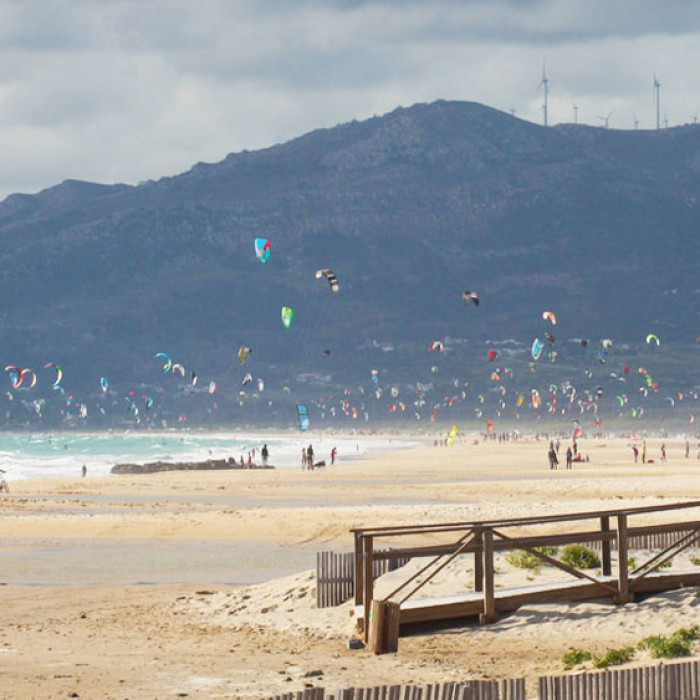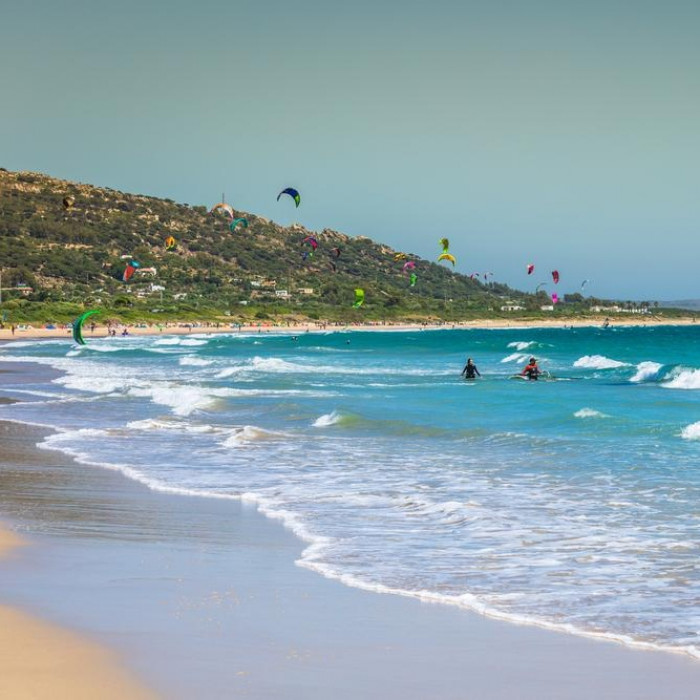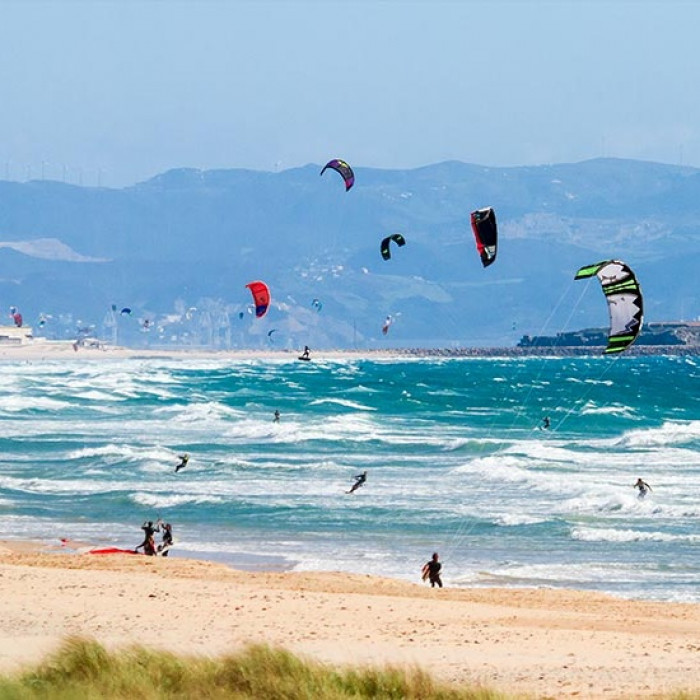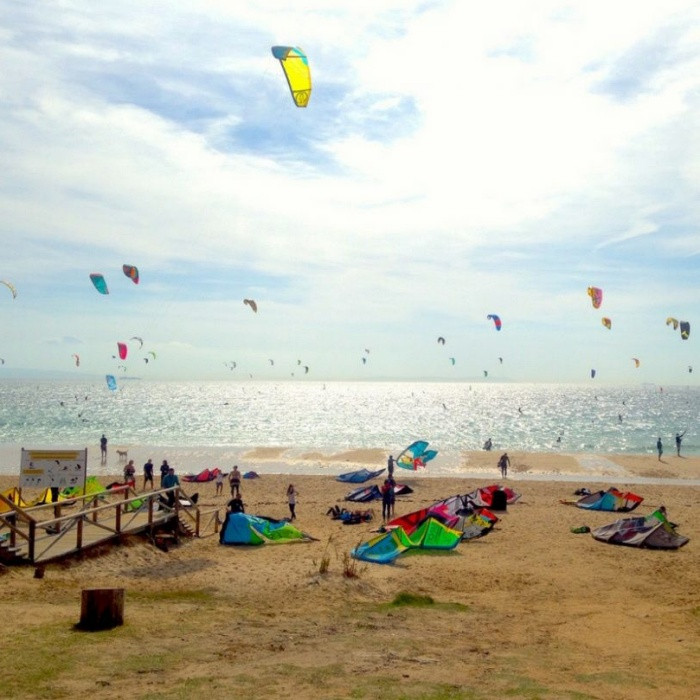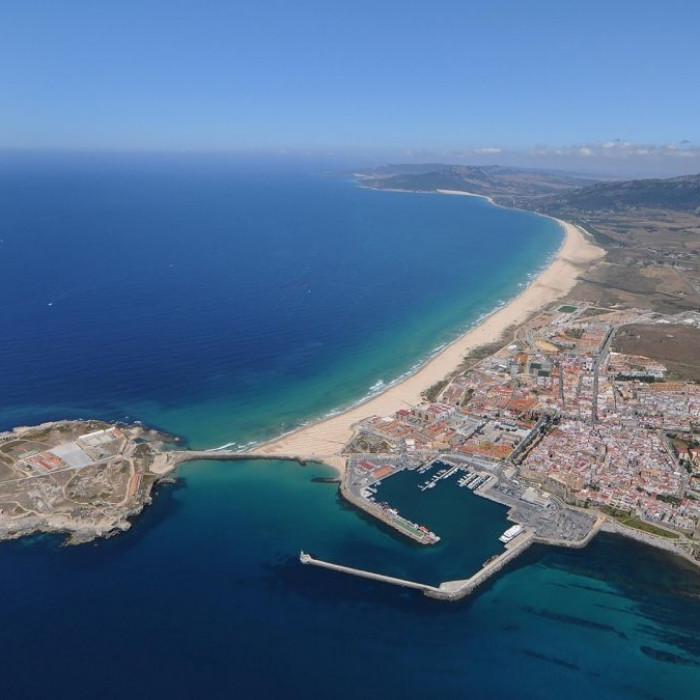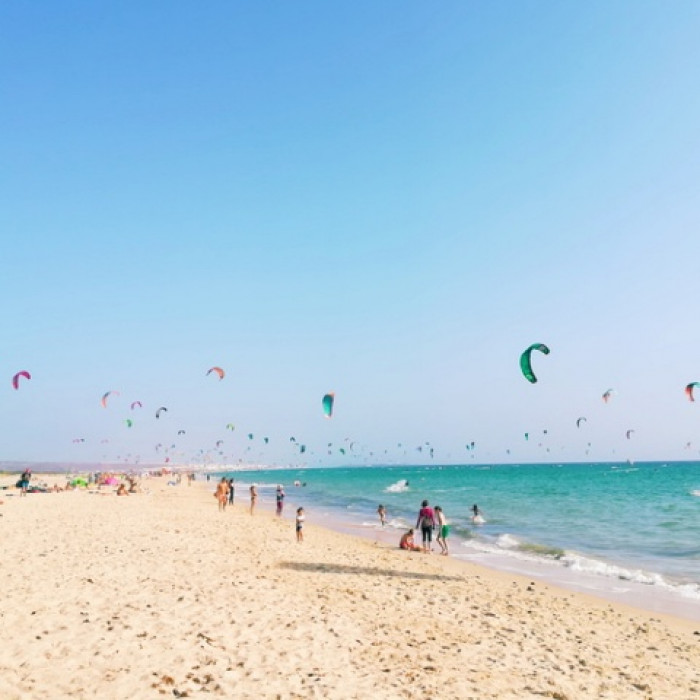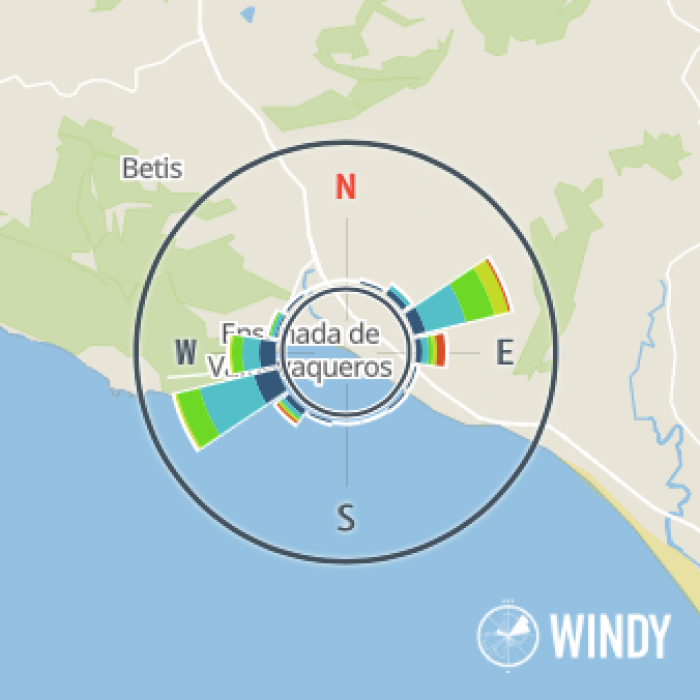Kitesurf at Tarifa
Los Lances & Valdevaqueros
- Overview
- Good to know
- Getting there
Overview
Located at the southernmost part of Europe, Tarifa is a true kitesurfer mecca: over 300 days of wind per year, vibrant and colourful history, Spanish culture and food, fantastic atmosphere and the views of the African coast. No wonder windsurfers entirely occupied this town in the early 80s, now best known as an all watersports location, Tarifa offers over 18km of the beach and the possibility to kitesurf pretty much all year round. November to February is counted as a winter season, and many kite schools and businesses in the city close down. Still, most of the seasoned kitesurfers and locals prefer these times of the year as there are no tourists and no restrictions where to kitesurf. The official kiteboarding season starts from March as the weather gets warmer and most of the businesses begin to open up for the year. Summer is the hight of the season, meaning a lot of kiters and holidays makers come here to enjoy the Spanish sun, but it also means some restrictions in kiteable areas. We cover this in more detail in the 'Beach' section. The reason why Tarifa is so popular between the watersports enthusiasts is that the town and the surrounding area is entirely built to cater to their needs. The central town is very vibrant with has plenty of options to eat and to have a fun evening, most post kite apres action can be found in a little square at the Surf Bar Tomatito and Taco Way Bar. If you stay in town, you will find everything you need from take-aways and supermarkets all walking distance, but you will need to travel to the main kite spots. If you want to stay directly at the kite spots, your best options are to stay around Valdevaqueros or Los Lances. Both locations have beach bars and cafes, hotels and other accommodation options that will make your stay very comfortable. Keep in mind that if you want to go to town, you will have to take public transport or have a car. Tarifa is made for watersports participants, but if you are travelling a non-kiters, they will have plenty to do here too. The main kite spots have fantastic cafes and bars, and other options are: taking a ferry for a day trip to Tangier, Morocco; exploring the Tarifa Old town and visiting the Castillo de Santa Catalina; visiting Estrecho Natural Park or going whale watching. Also, you can find a wakeboarding park in Marbella. Note for beginner kiteboarders: - The wind in Tarifa is sometimes very strong Levante (cross/cross-off-shore), and the water is deep straight from the shore. If you are still a beginner or didn't kite for a while, we highly recommend getting an instructor for at least a day or two. - If you are thinking to learn, then you will find many kite school around, and there is a dedicated shallow water lagoon where the beginners can learn safely. For more experienced riders don't forget that on the days with the offshore Levante winds, you should buy a safety/transfer boat service from the local schools (search 'Sea Angels Tarifa') as it will cost you around €200 if you need to be rescued.
Good to know
VISAS: Generally not required for stays of up to 90 days per 180 days. More information can be found in this guide. CURRENCY: EUR PRICES: Beer: €1-2; Food: Lunch €10-20; Accommodation: €10-50 pp; Kite Lessons: 6H €300; Kite Gear rental: €20 per hour. LANGUAGE: Spanish INTERNET: Wifi freely available, for better internet connection or a longer stay, buying Local SIM card is recommended. TRAVEL ADVICE: Even for the summer days bring some warmer clothes, after the all-day kiting sessions in strong winds or at the off-season times you may find a need to keep yourself warm and cosy when the sun goes down. Locals eat dinner quite late around 9 pm, so most of the evening parties also start quite late. We highly recommend renting a car at the airport, as it only costs around €100 for a whole week. Check this Lonely Planet guide for detailed health and insurance advise while traveling to Spain. TEMPERATURE: Water temperatures range from 15 – 22°C / 59 - 71°F depending on the season, so a light wetsuit is required most of the year. For the windy days, a windbreaker jacket may be handy. And for hot summer days to can brave out in a shorty, but if the wind is strong, then the wind chill will take its toll. In the off-season times full (5/4mm) wetsuit is recommended. The air temperature can reach 30°C / 86°F and more in the summer months and can drop to 11-20°C / 51-67°F in the early season. There is plenty of sunshine all year round, and the weather is warm, but a sweater and a pair of jeans will come in handy after sunset.
Getting there
NEAREST TOWN: Tarifa NEAREST CITY: Algeciras NEAREST AIRPORT: Gibraltar International Airport [GIB] 48Km, Jerez de la Frontera [XRY] 122 Km, Malaga airport - Costa del Sol [AGP] 160Km, Seville Airport [SVQ] 205Km. The easiest way to get to Tarifa and the kitesurfing areas around town would be to fly to Gibraltar or Malaga Airports and get public transport (bus or a taxi) or rent a car. For public transport services speak with your accommodation provider and search for the arrival airports website. GETTING AROUND: Majority of kitesurfers travelling to Tarifa often choose to rent a car for the duration of their stay as the car rental prices in this region are extremely low. You can get very comfortable all-rounder for less than a €100 for a week. If renting a car is not an option, then you can always try finding accommodation closer to the kite spot or if staying in Tarifa town, use the public busses to get to the kite spots. Please note that few busses are running from Tarifa town towards north along with the kite spots; however, this service only really runs in the peak season Jun-Aug. Another option is to ask if the kite schools that run from the Town will give you a lift, especially if you are hiring equipment or having lessons with them that should not be an issue.
- Beach
- Wind
- Rules/Hazards
Beach
Just a few minutes car ride from Tarifa’s old town you will find many kitespots that will suit any riding style. Note that the water condition option varies from flat water lagoons to an open ocean chop, some winter swells can bring some waves, but they never really reach the big wave riding type. Wave freestyle is very popular here as the wind chop can create very nice kickers here. Certain parts of the coast are good for surfing small waves, however, kiting there is not recommended. In front of the town, you will find a pro spot - Balneario. Only off-shore Levante winds work here, and there is no safety cover; therefore, it counted only an advance rider spot. Worth a visit in a very strong wind day to see some crazy local riders and pros jumping over the connecting footpath to Punta de Tarifa. Town Beach - This is the main beach nearest to Tarifa town and kiting is forbidden here from 1st June to 30th September, but not restricted outside those dates. Los Lances located between Campo Futbol and the Hurricane hotel - this is the central kite spot closest to the town. This part of the bay works best in Poniente but is usually offshore and gusty in Levante. Los Lances (South) starts at the football grounds and finishes at the river Jara. In the summer months, you will find dedicated kiting zones and many tourists doted around those areas. So it is worth getting there early to secure the space and avoid the traffic at the busy times. Los Lances Norte has most of the kite schools, accommodations and bars and cafes made for watersports lovers in one place. Large golden sand beach and plenty of parking all the way along. Valdevaqueros stretches past the Hurricane Hotel to the Punta Paloma entrance for the dunes. A beautiful 3km stretch of beach that is great in Poniente winds and can be kited (with caution and safety boat cover) in some Levante winds. Punta Paloma or otherwise known as the dunes, are the northernmost part of the beach. This area is perfect in Poniente winds as it's on-shore/cross-on-shore position and offers a safe bay in Levante winds that blow cross-shore here. It tends to be quieter with sunbathers at this end of the bay as it's a 10km drive from Tarifa, and at the lower tide beginners will find some waist-deep water closer to the beach. This beach can be kited all year round without restrictions. Alternative spots: If you are willing to drive further, you can reach some other fantastic location not far away from Tarifa. To the North West, you can go to Los Canos De Meca or Bolonia; these locations offer a small swell for the wave riding enthusiasts. To the South East of Tarifa, you will find many locations that are great for less gusty Levante winds and maybe less extreme for the beginner riders. Getares - only 15 min drive from the Algeciras, this location is a perfect alternative for less experienced riders when Levante winds are blowing strong in Tarifa. Here you will find the wind to be more gentle and blowing in the onshore direction. Palmones located south-east of the Algeciras is a spot that many kite schools use when the Levante winds are extremely strong. It provides a perfectly sheltered bay and a flat water lagoon for those wanting to improve their skills. Sotogrande is located around 50min drive from Tarifa and offers perfect flatter water river estuary during the Levante winds. Please note in the summer months there might be some sunbathers around. AMENITIES: Kite School, Gear Rental, Rescue Boat, Gear Storage, Kite Shop, Kite/Gear Repair, Toilets, Shower, Parking, Accommodation.
Wind
There are two wind directions in Tarifa: Poniente wind blowing from the W-SW (from the Atlantic) onto the main kite spots around Tarifa providing onshore/cross-on-shore wind direction. This wind is more common outside of the main summer and winter months as it is accelerated by the thermal effect of hot air rising from the Spanish mainland and cooling off over the Atlantic ocean. Generally calmer in the mornings and picking up consistently in the early afternoon, averaging 15-25 knots. Most used kites 10-15m or smaller kites if hydrofoiling. The notoriously known Levante wind blows from the Mediterranean along the Spanish coastline. It gets squeezed through the Strait of Gibraltar, which causes a venturi effect and accelerates the winds from the E-SE wind direction. The Levante winds are more most common in the summer and winter months and can blow for days on end, but it's noted that it comes in up to 2 weeks cycles during the summer months. The wind strength can reach up to +50kts, but more commonly between 25-40kts in Tarifa. It is generally gusty and blows off-shore to cross-off-shore depending on its precise direction. For those strong and off-shore wind days, there are many alternative beaches that you can explore at the other side of Gibraltar (like Getares, Palmones, Sotogrande) offering steadier and onshore Levante wind experience. If you are planning to kite at the main kite spots in Tarifa during Levante winds, there is a rescue service called 'Sea Angels Tarifa’ that allows you to buy a card for between €30 to €50 for a number of rescues for a whole season. We recommend looking into it as its much cheaper than €200 per rescue that you will be charged and it can save your life. WIND DIRECTIONS: E-SE, W-SW WINDIEST MONTHS: High Season - May, June, July, August, September. Mid Season - April, October, November. Low Season - December to February.
Rules/Hazards
The beach area along the whole coast is relatively large, sandy beach; therefore, the usual precautions when launching and landing the kite should be considered. Note that in the hight of the season, especially June to August the beach can be very busy with not just watersports enthusiasts but also a general public therefore extra care when kitesurfing and launching should be taken. This location is tidal; what you need to look at here is water depth. At certain times of the high tide, the current and the chop of the water at the beach can be intense, and for those still learning this area can be quite tricky. With the offshore Levante winds, we recommend getting a safety/transfer boat service from the local schools (search 'Sea Angels Tarifa') at the beach as it will cost you around €200 if you need to be rescued. *If you need kite related service like kite repairs, lessons or beach assistance please contact with the local operating kite centre or camp. ** We always recommend seeking additional knowledge about the spot from local Kite School or qualified instructors.
Info
Rider Level:
- beginner, intermediate, advanced
Discipline:
- freeride, waveriding, foiling
Spot Type:
- Open water, Small wave (up to 1m), Flatwater
Launch area:
- Sand
Tidal:
- no
Windiest Months:
- Apr, May, Jun, Jul, Aug, Sep, Oct,
Around Tarifa
Things to do
The latest shots
photo gallery
You’ve read all about it, now feast your eyes on your next kiting destination.
